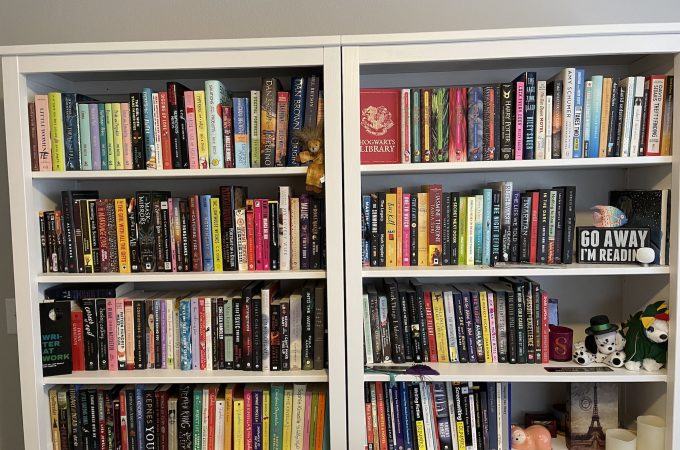
20 creative writing tips for 2020
It’s that time of year to set resolutions and as we move into the ‘20s and into a new decade. With a new year comes new goals and changes we want to make in our lives and one of my goals for 2020 is to finish my current Work in Progress (WIP).
Thanks to NaNoWriMo I made it to almost 60,000 words in my WIP and am excited to finish it this year. Writing those 60,000 words weren’t always easy but I did learn some writing tips and tricks along the way that I thought would be fun to share as other writers set their 2020 goals and resolutions.
Here are 20 creative writing tips for 2020 to make this year the one you finish a WIP or two!
1. Write for you
When it comes to creative writing, write for you and about what you love instead of trying to write something you don’t love that you think is marketable. It’ll show in the writing and pacing of your story. If you love your work and the genre you write it, you’ll find your target market who will appreciate the passion behind your story and the time you took to carefully craft it instead of just writing something to sell.
2. Do your prep work
Take your time to outline your novel and know where your story is going so you don’t get stumped along the way or find out the story isn’t working when you’re 75% in. I’ve started using the Save the Cat method that incorporates 15 beats or scenes a story needs to include as well as chapter outlines to show what scenes are in each chapter, what’s the point of each chapter, and how it contributes to the overall plot.
I used to be a pantser, not a plotter, but I’ve found my stories flow a bit better when I know what each scene is leading to next and where I want the story to go. It also makes sure I’ve worked out subplots and tied up all my loose ends by the end of the book.
3. Actually write
One trick I’ve picked up along the way is to write out story ideas by hand as it forces me to slow down and think through what I’m writing. I can jot down major plot points or scenes I want for subplots or even pieces of dialogue I want to work in. I think writing by hand is different than typing away at the computer and can help you think about your writing in a different way.
4. Ask questions
Sometimes you just know how you want your book to go, but asking questions about your characters or what could happen next can often lead to awesome plot twists, foreshadowing, or insights into your characters that adds depth to your story.
Some questions I’ll ask myself as I’m starting to outline my works include:
- What could happen to my Main Character (MC) that would make their situation worse and add new conflict?
- What does the MC need to complete their character arc or reach their goal?
- Does your MC have agency? Are they an active participant in directing their story or are they just along for the ride?
- Is the MC a flawed character or encountering setbacks they’re responsible for?
- Who is the antagonist? How are they similar to and different from the MC? What’s their motivation or goals?
- How will the protagonist defeat the antagonist?
- Who will help the MC along the way? How will they impact the story or help the MC grow?
- What’s the purpose of each scene?
- How would the scene change if the setting changed?
- Are all the characters in the scene necessary? Could they be replaced by lamps and it wouldn’t change the scene?
5. Get to know your characters
To drive your story forward and build up the conflict, you have to know what each character’s motivations and goals are, who they are as a person, what their purpose in the story is, and where they’ll end up at the end of the story. If you don’t know your characters or why they do what they do, why should your readers take the time to get to know them?
Know your characters inside out or you won’t be able to convey who they are to your readers or get them to care about your characters if they’re not well-defined and complex.

6. Show, don’t tell
Yes, it’s a classic writing tip but an important one. I’ve seen plenty of novels that simply tell me information or tell me what’s happening in their novel and it’s boring! Don’t tell me how the characters feel, how I should feel reading it, or what’s happening in the scene – show me! If written well, I’ll draw the conclusions the author wants me to and feel what the author wants me to without being explicitly told.
7. Introduce conflicts
No one wants to read a story where the MC has no challenges or gets everything handed to them on a silver platter. Self-insert fantasies are famous for conflict-free stories and they’re not exciting for that very reason. A story needs conflict to drive action and show how the MC has grown and changed for the better as at our core, we all want to grow as people and see characters succeed by learning and overcoming their flaws.
Conflict doesn’t just have to be your MC versus a big bad antagonist in an epic battle. Your conflicts could be internal, the MC versus themself, or versus society, or finding balance in a strained relationship. There are lots of types of conflict you can work into your WIP to help your MC complete their character arc.
8. Foreshadow future plot points
One great thing about outlining your novel and knowing where the story is going is being able to drop hints and foreshadow future events earlier in your writing process.
You can work it into clever bits of dialogue that work both in the present moment and at the pay-off, set up a certain character or a character’s motivation ahead of time, or even put something in the background that will be important later.
9. Misdirect your readers
Misdirects or red herrings are great devices for adding suspense and conflict to your story as your readers try to figure out who’s up to something. Red herrings keep our attention focused on a character or subplot that’s often revealed to be nothing while the real villain was in front of our faces the whole time. It’s a fun way to keep your readers engaged and trying to figure out what will happen in the end before it’s revealed.
Try not to botch your red herrings with “dead herrings” – a play on red herring I saw first on Das Mervin’s blog – by trying to misdirect readers by telling them what the twist is but having the characters say there’s no way it’s really that.
It’d be like if in Harry Potter and the Sorcerer’s Stone J.K. Rowling had had Hermoine guess that Professor Quirrell had Voldemort on the back of his head but every other character laughed it off and said there’s no way it’s that, don’t even think that! Rowling had set up a perfect red herring in Snape, where we closely watched him even though in the background Quirrell was doing shady stuff that made sense upon the reveal.
10. Write dialogue that moves the story forward
Have you read stories where the main characters are having a realistic but boring conversation? Maybe something like:
“Hey, Jane,” Michael called out.
“Hey, Michael! How’s it going?” Jane asked.
“Oh, I’m good, and you?” Michael asked.
“I’m well. How’s work?” Jane inquired.
It’s realistic but in the end it’s pointless. Skip the boring parts of speech or summarize them to get to the dialogue that moves the story forward. The readers don’t need to see these pleasantries unless there’s subtext behind them, like the characters are being polite even though their body language is not.
Use dialogue wisely to share exposition, plot points, or demonstrate your character’s personality or relationships with others in the story. We have these boring conversations every day, we do not need to see them in print.

11. Set word count goals
One way to hold yourself accountable for writing is to set daily or weekly word count goals. During NaNoWriMo I had daily writing goals of about 1,700 words per day, but now I’ve switched to weekly word count goals as it’s not always feasible for me to write every day.
Having a word count goal can keep you motivated as it’s in your face whether you’ve met your goal or not and are adding to your story. It also makes the idea of finishing a WIP in 2020 more feasible as it’s broken down into smaller, more manageable goals.
12. Schedule writing time
Like any resolution, it requires change in your life to achieve it and you may have to change your schedule around to work in dedicated writing time. Like I said above, in November I wrote every day as a part of the NaNoWriMo challenge but won’t be able to keep up that schedule with work, my blogs, and other commitments.
But I do schedule writing time during my week to make sure I get to it. Find a way to set aside 30 minutes to an hour at least one night a week to focus on your creative writing and get your WIP complete.
13. Create an environment
Just like your mood or state of mind can impact your writing, so can your writing environment. Eliminate distractions like the TV and tell your family or roommates that you’re going to be writing and shouldn’t be disturbed.
I prefer writing at a desk where I can have my outlines and notes nearby, something to drink available, and headphones so I can listen to music if I want to drown out other noises.
14. Try the Pomodoro technique
Having trouble focusing on your writing? Try eliminating distractions for a short amount of time. The Pomodoro technique means you focus on one task or project for 25 minutes and then you get a nice five-minute break.
It works because you can definitely focus for 25 minutes straight as you add to your word count and then you’ll be able to check email or social media during your break so you’re less distracted during your sprint.
15. Read
They say you can’t be a writer without being a reader and I fully agree. While I’m reading, I’ll make notes of scenes that work well, settings that are well described, characters I like and why I like them, and humor I think I can adapt to my own work. Reading shows us good writing in action and can help us improve our own WIPs or even think of new directions we can take our story.

16. Play around with a different POV
Feeling stuck with a certain scene? Write it from a different perspective! I have stories that are written in third-person and first-person and sometimes swapping a scene can help me describe what’s going on better, get in touch with the emotions, or show what other characters are doing instead of just telling.
Obviously you’ll need to go back and revise it to fit with the rest of the narrative but it’s a great exercise when you’re not sure how to proceed with a certain scene or bit of action.
17. Edit later (and sober)
I love the misattributed quote to Hemingway that goes, “Write drunk, edit sober.” One, it’s funny, two, it can sometimes help by letting the ideas flow and not caring so much about word choice but at least getting something down. But, the trick is to edit your work later.
I’ve seen other writers say they’ll finish a draft and then put it away for three to six months before revisiting it! That sounds insane but is also good advice. I’ve found when I try to edit my own work right away I’m still too deep in the story and can’t read it the same way a first-time reader would.
I plan on finishing my story and sharing it with family and friends who I know can provide some constructive criticism and then read through it on my own to see if my edits match up with others. This gives me time away from the story as well as third-party feedback.
18. Read your work aloud
One way to spot troublesome sections or areas that aren’t working are to read your story aloud. You’ll read it slower than you would in your own head and it makes you notice any errors better as your brain won’t skip over them.
Reading aloud also calls attention to your pacing and sentence length, helping identify areas you can trim or expand.
19. Share your WIP with a friend
Like I said above, I plan on sharing my first draft with people who I know will provide quality feedback but also love me and won’t want to crush my hopes and dreams. I can talk to them about what’s working, what’s not working, and get feedback from a real reader and not a professional editor. Yes, it will make its way to a professional editor, but I think getting opinions from an everyday reader is also invaluable.
20. Get professional help
Consult the professionals for advice on plotting, characters, and dialogue when you’re getting started. Some of my favorite writing books include:
- Save the Cat! Writes a Novel: The Last Book on Novel Writing You’ll Ever Need, Jessica Brody
- Structuring Your Novel, K.M. Weiland
I’ve also had a subscription with Scribbler for a few months and love getting monthly boxes covering different parts of writing and getting some fun writer-themed goodies, like notebooks, pens, writing journals, candles, coffee and tea, and so on. It’s a nice little motivational box that inspires me to keep going on my WIP.
What’s the best writing tip you’ve ever heard? Share in the comments below or on Twitter!





